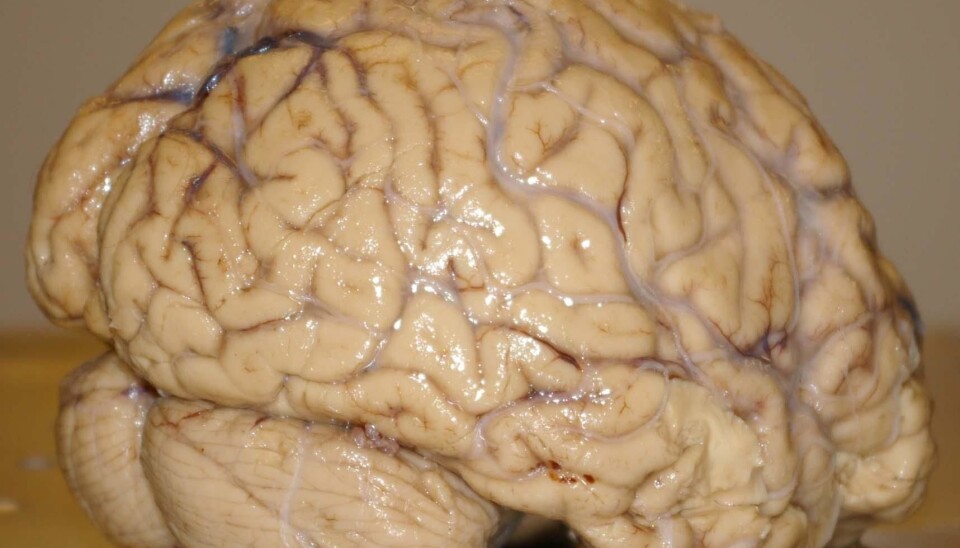This article was produced and financed by Oslo Metropolitan University

Highly developed brains behind top performances
World-class performers in management, sports and music often have a uniquely high mind-brain development.
Denne artikkelen er over ti år gammel og kan inneholde utdatert informasjon.
Brains of such performers function in a way that makes them have peak experiences.
These experiences are characterized by happiness, inner calm, maximum wakefulness, effortlessness and ease of functioning, absence of fear, transcendence of ordinary time and space, and a sense of perfection and even invincibility.
Dr. Harald S. Harung at Oslo and Akershus University College of Applied Sciences and international colleagues have carried out four empirical studies comparing world-class performers to average performers within management, sports, classical music, and a variety of professions, such as public administration, management, sports, arts and education.
"Everyone wants excellence. Yet, current understanding of high performance is fragmented. What we have done in our research, is to use quantitative and neurophysiological research methods on topics that so far have been dominated by psychology," says Harung.
"What we have found, is an astonishing integration of brain functioning in high performers compared to average-performing controls," he says
"For example, we are the first in the world to show that there is a brain measure of effective leadership."
Peak experiences
The first study was done on world-class athletes selected by the National Olympic Training Center in Norway and the Norwegian School of Sport Sciences.
Besides screening athletes’ brains using EEG, each athlete was interviewed about their experiences while performing at their very best. The result was a wide range of peak experiences, which are the most happy and fulfilling moments in a person’s life.
Former cross-country skier Thomas Alsgaard, who won 11 gold medals in Olympic Games and World Championships, said:
“The senses are so open that you have the ability to receive signals that are almost scary: In a way it is a ‘high.’ I receive an unbelievable amount of information. Much, much more –10-20 times more information – than what I manage to take in if I sit down and concentrate and try to perceive things. But I am so relaxed. And the more relaxed I am, the more information I register.”
Alsgaard also points out how he thinks this work:
"Deeper aspects of the mind have much greater potential. Much, much greater potential. The intellect, experiences, and knowledge lie at the back of the head, in the unconscious…My experience after many years at the top is that there is tremendously much in the mental, tremendously much. … when everything is at the very highest level, then I feel invincible. The up-hills are not long enough nor steep enough; an extremely good sensation.”
"I just watch what happens"
Another athlete that participated in the research is the Norwegian handball keeper, Heidi Tjugum, who was part of the Norwegian national team that won one World Championship, one European Championship, two European Cups and a number of silver and bronze medals. She says:
“Sometimes I have felt that I am an observer—I just watch what happens. This is a good feeling. It is a very beautiful feeling; it is not that I feel I don’t have control. But it goes by itself – in reality I do not have to initiate anything at all. Extremely here and now—nothing else matters. And it is unbelievably good. A beautiful experience. These feelings are unbelievable nice. They stimulate me to take on further challenges. Obviously, this is what I am longing for every time I go to a training session, to have this sensation that OK this I master so well that it is just for the opposing players to come at me. Just shoot! Whatever you do, you will not be able to score!”
These statements are similar to those Harung and his colleagues gathered from other top-class performers, both among the musicians and the business leaders.
They found a significant difference amongst the top performers and controls on several quantitative measures.
"Therefore, there must be some common inner attributes and processes that make top performers able to deliver at top level, regardless of profession or activity," says Harung.
"We found this common inner dimension to be what we called higher mind-brain development."
Higher mind-brain development includes that various aspects and parts of the brain work together in an integrated way. Among world-class performers this integration is especially well developed.
Measured brain activity
Studies the researchers have carried out include measurements of the performers’ brains by the means of electroencephalography, EEG. This is equipment and methods which hospitals often use in search of possible brain injuries, following traffic accidents etc. EEG, however, can also be used to look at the extent of integration and development of several brain processes.
The researchers have looked at three different measurements, that all reflect how well the brain works as a whole: 1) Coherence, which tells how well the various parts of the brain cooperate, 2) Amount of alpha-waves, which reflect restful alertness, and 3) How economically or effectively the brain works.
The three measurements are then put together in an expression of brain refinement, the Brain Integration Scale.
World-class performance has so far been mostly regarded from a psychological point of view, especially speaking of management. Researchers often explain management skills as a result of special personal or psychological characteristics that some have, and others don’t.
"Our research in brain activity and brain integration is done from a more natural science angle. By such means, we hope we are closer to a good and more comprehensive understanding of why some succeeds better than others," says Harung.
In all the groups of top performers, measurements were checked by using control groups. The controls were average performers, e.g. low-level managers or amateur musicians. The data gave one surprising result:
Among the musicians, both the professionals and the amateurs turned out to have a high level of brain integration. In the two other studies, this measurement showed major differences between the persons with top level performance and the control groups.
"We believe that for musicians, the explanation might be that classical music in itself contributes to such integration, regardless of your performance level," says Harald S. Harung.
Presenting new theory
The research group states that their world-class performance studies are in support of a Unified Theory of Performance. This theory suggests that higher levels of mind-brain development form a platform for higher performance, regardless of profession or activity.
"It seems like these mind-brain variables represent a fundamental potential for being good, really good, in the particular activity one has decided to carry out," says Harung.
For all three studies the researchers also found that top level performers outscored the control groups in a test of moral development.
Higher moral development implies an expanded awareness where one is able to satisfy the interests of other people and not just their own needs. Harung finds it remarkable that high levels of performance, in a wide spectrum of activities, are connected to high moral standards.
"This should give an extra push to act morally, in addition to a better self-image, fewer sleepless nights and a good reputation," he says.
"The key to top-level performance, therefore, seems to be that we make more use of our inherent capabilities. The development of brain integration, moral reasoning and the frequency of peak experiences usually end at about the age of 20," says Harung.
Former research, however, has indicated that transcendental meditation can create further development of these variables, also during grown-up years.
Scientific links
- Higher psycho-physiological refinement in world-class Norwegian athletes: brain measures of performance capacity, Scandinavian Journal of Medicine & Science in Sports, Vol 21, Issue 1, pages 32–41, February 2011, doi: 10.1111/j.1600-0838.2009.01007.x.
- Moral development, executive functioning, peak experiences and brain patterns in professional and amateur classical musicians: Interpreted in light of a Unified Theory of Performance, Consciousness and Cognition, Vol 20, Issue
- Higher mind-brain development in successful leaders: testing a unified theory of performance, Cognitive Processing Vol 13, Number 2 (2012), 171-181, DOI: 10.1007/s10339-011-0432-x


































